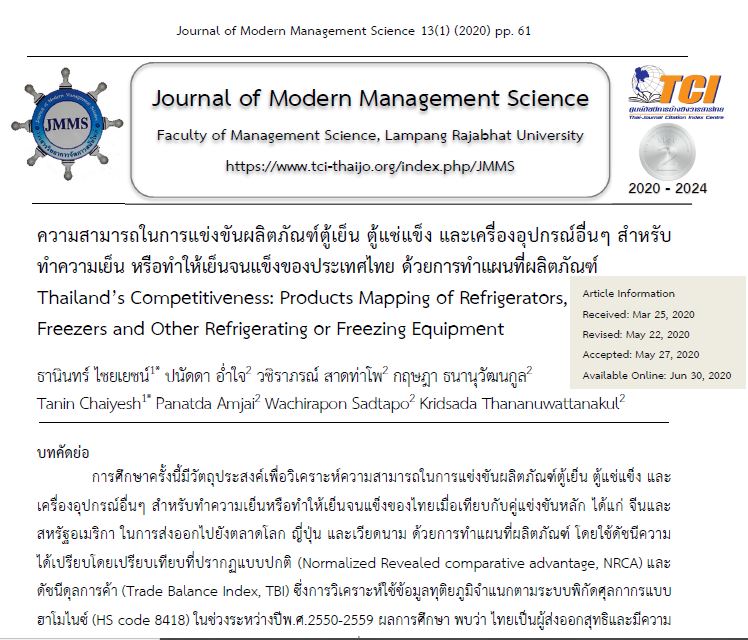Thailand’s Competitiveness: Products Mapping of Refrigerators, Freezers and Other Refrigerating or Freezing Equipment
Main Article Content
Abstract
The purpose of this study was to analyze the Thailand’s competitiveness of refrigerators, freezers and other refrigerating or freezing equipment in comparison with that in the People’s Republic of China (China) and the United States of America (USA). In question were exports of these products to world markets, Japan, and the Socialist Republic of Vietnam. Using product mapping approach based on normalized revealed comparative advantage (NRCA) and trade balance index
(TBI). The analysis of secondary data as falling under the product category of Harmonized System (HS code 8418) in the period between 2007 and 2016. The results of the study showed that Thailand was a net exporter and had a revealed comparative advantage in a particular commodity to world markets, Japan and Vietnam. China was a net exporter and had a revealed comparative advantage in a particular commodity to world markets and Japan. However, even China was the net exporter, but there was a comparative disadvantage in exporting to Vietnam. USA was a net importer and had a revealed comparative disadvantage by comparing it to export to the world markets, Japan and Vietnam. This study suggests that even Thai has the revealed comparative advantage of the products by comparing it in exporting, but to maintain competitiveness, manufacturers/exporters of the products and related agencies of Thailand should cooperate with each other to find a way to optimize the production and export of the products.
Article Details
The article must be considered and accepted for publication by the editorial board of the Faculty of Management Science, Lampang Rajabhat University. The articles have been reviewed by a peer (peer review) and the author must update according to the suggestion if available before publication. Articles that are not considered the editorial team will inform the results of the consideration but will not send the original to the author.
JMMS is the Faculty of Management Science journal, Lampang Rajabhat University. Jmms published both print and online editions. We allow the use of articles for academic use under the scope of copyright law.
References
ดวงรัตน์ ประจักษ์ศิลป์ไทย. (2558).การส่งออกของไทยในปัจจุบัน. [ออนไลน์]. สืบค้นเมื่อ 2 กันยายน 2561, จาก https://library2. parliament.go.th/ebook/content-issue/2558/hi2558-043.pdf.
กรมส่งเสริมการค้าระหว่างประเทศ. (2561). การค้าระหว่างประเทศของญี่ปุ่น เดือนมกราคม-สิงหาคม ของปี 2559 และแนวโน้มเศรษฐกิจ. [ออนไลน์]. สืบค้นเมื่อ 2 กันยายน 2561, จากhttps://aec.ditp.go.th/ditp_web61/article_sub_view.php?filename=contents_attach/229460/229460.pdf&title=229460&cate=402&d=0.
ศูนย์ข้อมูลเชิงลึกอุตสาหกรรมไฟฟ้าและอิเล็กทรอนิกส์. (2562). ผลิตภัณฑ์ตู้เย็นปี 2019. [ออนไลน์]. สืบค้นเมื่อ 20 พฤษภาคม 2563 จาก http://eiu.thaieei.com/ProductProfileDetail.aspx?gid=14&y=2019&m=12.
สำนักงานส่งเสริมการค้าในต่างประเทศ. (2561). ภาพรวมอุตสาหกรรมส่งออกสินค้าไทยไปเวียดนาม. [ออนไลน์]. สืบค้นเมื่อ 2 กันยายน 2561, จาก https://www.ditp.go.th/ditp_web61/article_sub_view.php? Filename =con tents_attach/236187/236187.pdf&title=236187&cate=1005&d=0.
Ahmad, N., Qayum, A., & Iqbal, A. (2017). Evolving Patterns and Empirical Distribution of Normalized Revealed Comparative Advantage: A SAARC Countries Analysis. Journal of Applied Economics and Business Research, 7(1), 59–82.
Astrini, E. W. & Az Zakiyyah, N. A. (2018). Comparative Advantage Measurement in ASEAN’s Ten Leading Export Commodities: A Case Study of ASEAN-5. Journal Pendidikan Bisni dan Ekonomi, 4(1), 22–37.
Balassa, B. (1965). Trade Liberalization and Revealed Comparative Advantage. The Manchester School of Economics and Social Studies, 33(2), 99–123.
Bojnec, S. & Ferto, I. (2018). Drivers of the Duration of Comparative Advantage in the European Union’s Agri-food Exports. Agricultural Economics (Czech Republic), 64(2), 51–60.
Chaudhry, S. & Negi, Y. S. (2017). Export Competitiveness of Tea Industry: An Analysis of Major Tea Producing Countries. Journal of Arts, Science & Commerce, 8(4), 24–30.
Dalum, B., Laursen, K., & Villumsen, G. (1998). Structural Change in OECD Export Specialization Patterns: De-Specialization and Stickiness. International Review of Applied Economics, 12(3), 423–443.
Deb, K. & Bodhisattva, S. (2017). On Empirical Distribution of RCA Indices. IIM Kozhikode Society & Management Review, 6(1), 23–41.
Ishchukova, N. & Luboš, S. (2014). Revealed Comparative Advantage: Products Mapping of the Russian Agricultural Exports in Relation to Individual Regions. Acta Sci.Pol. Oeconomia 13(1), 45–61.
Lafay, G. (1992). The Measurement of Revealed Comparative Advantages. In: M.G. Dagenais & P.A. Muet (Eds.). International Trade Modeling. Chapman & Hill, London.
Laursen, K. (1998). Revealed Comparative Advantage and the Alternatives as Measures of International Specialization. DRUID Working Paper, 98–30.
Permatasari, I, D., Wilantari, R. N., & Lestari, E. K. (2019). The Dynamics of Changing Comparative Advantage in ASEAN-4: Flying Geese Model. Media Trend, 14(1), 33–40.
ShiratUllah, M. & Kazuo, I. (2012). Dynamics of Comparative Advantage and Export Potentials in Bangladesh. The Ritsumeikan Economic Review, 61(4), 1–14.
Topcu, B. A., & Sarigul, S. S. (2015). Comparative Advantage and the Product Mapping of Exporting Sectors in Turkey. The Journal of Academic Social Science, 18(3), 330–348.
Varshini, N. M. & Manonmani, M. (2019). Pattern of Trade and Trade Advantage in Pharmaceutical Industry in India. Journal of International Economics, 10(1), 50–60.
Widodo, T. (2008). Dynamic Changes in Comparative Advantage: Japan Flying Geese Model and Its Implications for China. Journal of Chinese Economic and Foreign Trade Studies, 1(3), 200–213.
Yu, R., Cai, J., & Leung, P.S. (2009). The Normalized Revealed Comparative Advantage Index. Annals of Regional Science, 43(1), 267–282.


